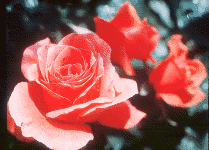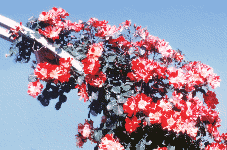 Candelabra Candelabra
Not even Lumiere, the famous candelabra from "Beauty and the Beast", could
hold a candle to the beauty of Candelabra, the 1999 AARS grandiflora winner.
Set against a torchiere of dark green, glossy foliage, the coral and orange
flowers flicker brightly. The lightly-scented grandiflora lights the garden
with its 4-inch flowers with 25 petals. Candelabra grows to a height of
4-feet -- an upright, well-balanced plant with its colorful flowers present
in large clusters. The plant is disease-resistant which translates to easy
care for the gardener. Candelabra was hybridized by Keith Zary from a combination
of Tournament of Roses and an unnamed seedling. Bear Creek Gardens is the
introducer. |
Kaleidoscope
As each turn of a kaleidoscope presents a myriad of different colors thanks
to the glass prisms locked inside, so does Kaleidoscope, the landscape
shrub AARS winner for 1999. The tan and lavender petals fade to lavender
pink along the tip creating color variations with each  movement
of the sun or the flower itself. The mixture of prism colors include the
medium dark green, glossy foliage which grows to a height of three to four
feet. The pointed buds open to reveal three inch flowers with 35-40 petals
and a slight, sweet scent reminiscent of damask. Kaleidoscope was created
by Bear Creek's John Walden, the newest breeder to join the AARS elite,
from a combination of Pink Pollyanna and Rainbow's End. Bear Creek Gardens
is the introducer. movement
of the sun or the flower itself. The mixture of prism colors include the
medium dark green, glossy foliage which grows to a height of three to four
feet. The pointed buds open to reveal three inch flowers with 35-40 petals
and a slight, sweet scent reminiscent of damask. Kaleidoscope was created
by Bear Creek's John Walden, the newest breeder to join the AARS elite,
from a combination of Pink Pollyanna and Rainbow's End. Bear Creek Gardens
is the introducer. |
 Fourth
of July Fourth
of July
Fourth of July, the first climber to win the AARS award in 23 years, reaches
skyward with a burst of vibrant colors just like the fireworks that inspired
the name. This velvety red and white striped climber features long canes
of 10 to 14 feet with medium to long stems wrapped in glossy, deep green
foliage. Unlike other climbing rose varieties in color and style, Fourth
of July brightly bursts forth with clusters of strikingly large, 4 1/2
inch flowers with 10 to 16 petals. Gardeners will celebrate all summer
long as repeat flowers explode in a shower of sweetly fragrant blossoms.
Fourth of July is the celebration of Roller Coaster and Altissimo. Fourth
of July is the premiere honoree to come out of AARS's new three year trial
for climbers. All other classes are subjected to two years of testing.
It was hybridized by Tom Carruth and introduced by Weeks Roses. |
 Betty
Boop Betty
Boop
She may have been born a saucer-eyed, bob-haired cartoon flapper in 1930,
but in 1999 she is blossoming once more! Betty Boop, the fourth AARS winner
for 1999, is an ivory yellow with a red edge floribunda that likes to flower
early and often during the growing season. The brightly colored clusters
of flowers dance coyly among deep green leaves and dark red new growth
to present a "Red Hot Mama" of color. Betty Boop is a naturally rounded
medium to tall plant with flowers and foliage to the ground, making an
ideal landscape plant. Additionally, the plant offers an attractive, moderately
fruity, sweet fragrance, a la her namesake -- the original Betty Boop,
star of over 112 cartoons in just nine years. Long, elegant and pointed
buds mature into 4-inch flowers with a petal count of 6 to 12. Originally
introduced in 1930 by Max Fleischer's Talkartoons for Paramount, Betty
Boop takes center stage again thanks to an introduction by Weeks Roses.
Tom Carruth choreographed Betty Boop from a combination of Playboy and
Picasso, just as Betty would want it! As Betty said in her last film in
1939 "Yip, Yip, Yippy" for remembering her 60 years later! |

